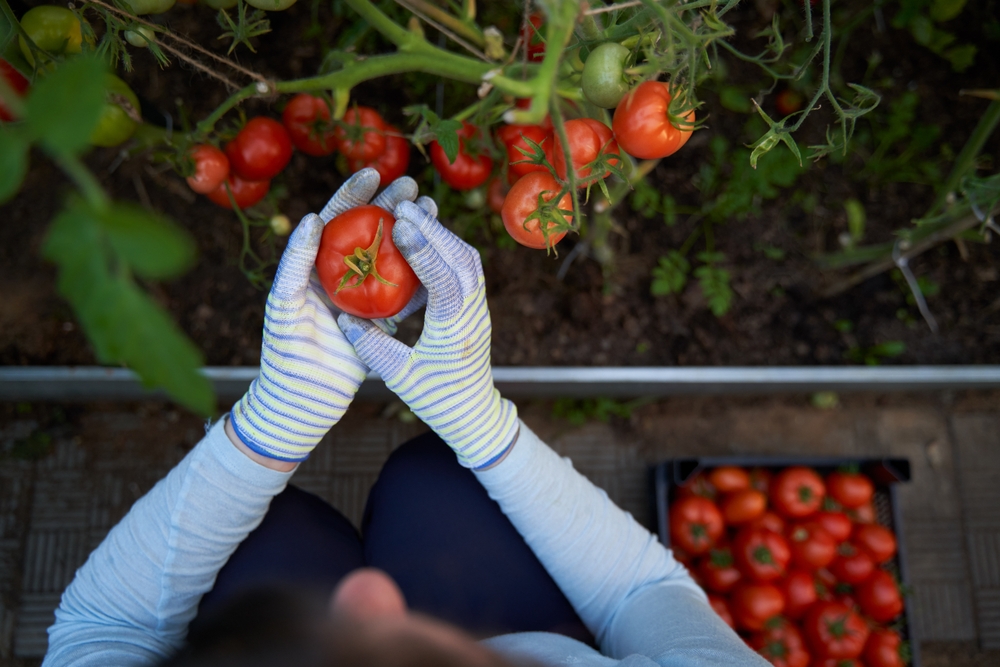
Image Source: Shutterstock.com
It’s the end of summer, and your tomato plants are still bursting with potential. The sun’s a little weaker, the nights are cooler, and those once-lush vines are starting to look a little tired—but the fruit? Still green, still growing, and still full of promise. You’ve worked too hard to let all those beautiful tomatoes go to waste just because the calendar flipped to fall.
The good news? With a few clever tricks, you can keep your tomato plants producing juicy, red, garden-fresh fruit well into October—long after your neighbors have packed it in.
1. Give Your Tomatoes a Cozy Cold-Weather Wardrobe
Once the temperatures start dipping into the 50s at night, your tomato plants begin to slow down. They’re warm-weather lovers through and through, so your job is to trick them into thinking summer’s still going strong. The easiest way? Start by covering them in the evenings with lightweight row covers, old bedsheets, or frost blankets. These act like little jackets, trapping in warmth and protecting your plants from sudden chills.
In the morning, remove the covers so the plants can soak up the sun again. If you want to get fancy, use hoops to create mini greenhouses around your rows—simple PVC pipe arches draped with plastic can do wonders. It’s a low-cost way to extend the growing season by several weeks. Think of it as giving your tomatoes a snug night’s sleep so they can wake up ready to ripen.
2. Prune Like a Pro to Focus the Energy
By late summer, your tomato plants start to look like a jungle—green everywhere, leaves overlapping, stems tangling like spaghetti. It might look impressive, but that wild growth actually slows ripening. At this point, your plants should focus all their energy on maturing existing fruit, not producing new flowers or unnecessary foliage. That means it’s time to grab the shears and do some strategic pruning.
Snip off any new blossoms that won’t have time to become ripe fruit before frost hits. Trim back excess leaves, especially those shading ripening tomatoes. Removing those energy-hogging shoots tells the plant, “Hey, let’s finish what we started.” Within a week or two, you’ll notice your tomatoes turning color faster. Pruning is basically the plant equivalent of decluttering—it lets your tomatoes breathe, focus, and thrive.
3. Mulch and Moisture: Keep That Soil Toasty
Fall’s cooler nights don’t just affect your plants—they chill the soil too, which can shock roots and slow growth. The secret weapon here? Mulch, and lots of it. A thick layer of straw, leaves, or shredded newspaper around the base of your plants helps trap heat, regulate moisture, and protect the roots from temperature swings.
Tomatoes love consistent warmth, and mulch acts like a cozy blanket for their feet. As an added bonus, it prevents the soil from drying out too quickly, meaning less stress for the plants. When temperatures drop further, you can even add another layer for extra insulation. Combined with your nighttime covers, mulch helps maintain a microclimate that feels more like late August than early October. It’s a simple step that pays off in plump, sweet tomatoes.
4. Pick Green—Then Ripen Indoors Like a Pro
Sometimes, no matter how hard you fight the chill, Mother Nature wins. When you know frost is coming and you still have tons of green tomatoes hanging on the vine, don’t panic—harvest them early and ripen them indoors. It’s easier than you think. Pick any fruit that’s full-sized and unblemished, even if it’s still green.
Place them in a single layer inside a cardboard box or paper bag along with a ripe banana or apple. The ethylene gas released by the ripe fruit speeds up the ripening process naturally. Keep the box in a cool, dark place—like a pantry or basement—and check them daily. Within a week or two, you’ll have ripe, garden-fresh tomatoes without ever stepping outside. It’s like cheating the season, and it feels incredibly satisfying.
5. Choose Your Late-Season Champions
If you’re serious about stretching your tomato season year after year, start thinking ahead—some varieties just handle the cold better. Certain tomato breeds, like ‘Stupice,’ ‘Siberian,’ or ‘Celebrity,’ are known for their resilience in cooler weather and shorter days. They mature faster, shrug off mild chills, and keep producing even when summer’s gone. The trick is to plant a few of these early or mid-season varieties alongside your standard favorites so you’ve got overlap when fall rolls around.
These hardy types don’t just survive—they thrive when temperatures start to dip. Pair them with your frost covers and mulch tricks, and you’ll still be harvesting long after your neighbors have ripped out their vines. Once you’ve tasted a sun-warmed October tomato, you’ll never go back to quitting in September again. Planning your tomato lineup this way makes every future season a little more abundant—and a lot more delicious.

Image Source: Shutterstock.com
Keep the Summer Spirit Growing
Extending your tomato harvest into October isn’t just about keeping plants alive—it’s about savoring every last bite of the season you worked so hard for. With a little protection, pruning, and planning, your garden can keep producing even as the air gets crisp and the sweaters come out. Every ripe tomato you pick in October feels like a small victory against the clock. Whether it’s a handful of late-season cherry tomatoes or the final, proud beefsteak of the year, those fruits taste even better because you earned them.
Have you ever managed to stretch your harvest past the usual cutoff? Share your favorite tricks, stories, or late-season wins in the comments below.
You May Also Like…
- 9 Fruits to Harvest Before the Birds Do
- 11 Harvesting Tricks to Avoid Bruising Produce
- 9 Vegetables You Should Still Plant in October
- The One Plant You Shouldn’t Put Next to Tomatoes – According to Gardeners
- Why Overripe Fruits Invite More Fall Pests
Leave a Reply